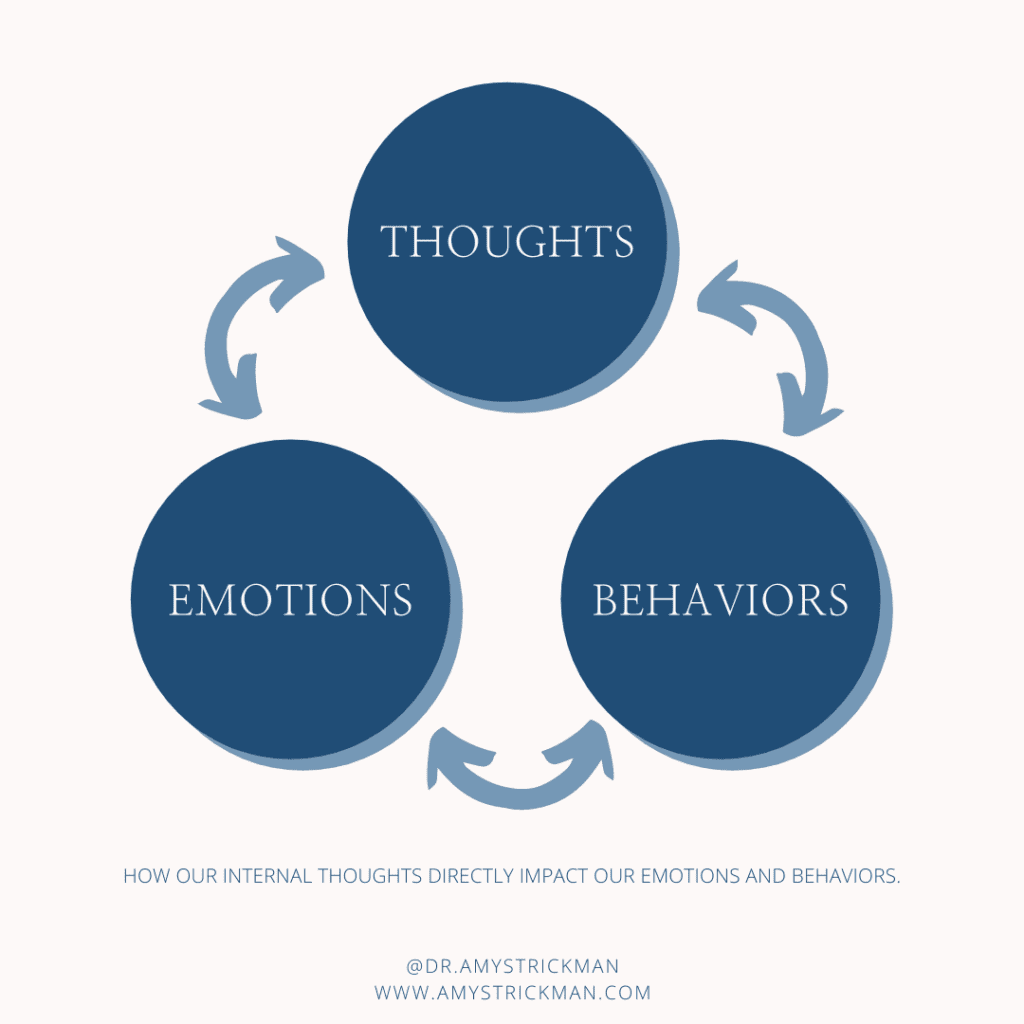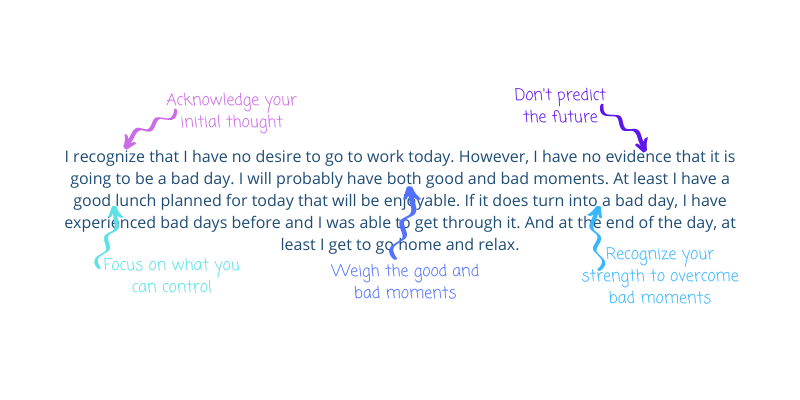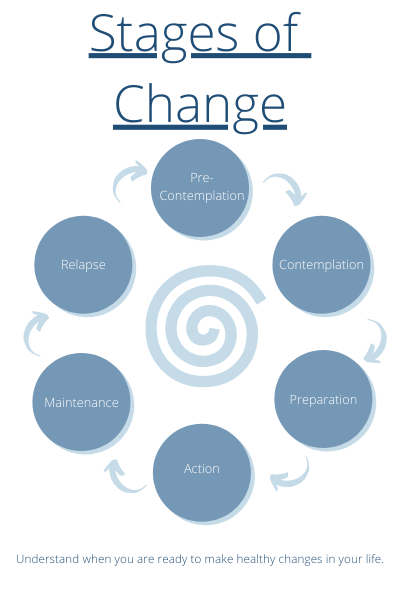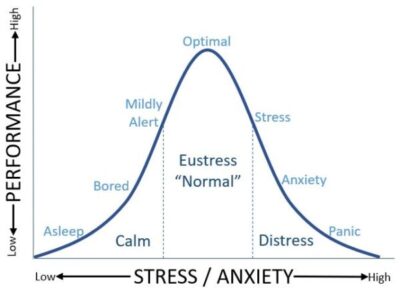5 Steps to Change Your Mindset

We all have this little voice inside our head. This little voice is oftentimes called our internal thoughts. That internal voice is constantly talking. Not only is it always talking, but it’s analyzing, judging, critiquing, and evaluating. It’s very opinionated. Our internal thoughts do not have an on/off switch; we cannot turn it off. But it does have a volume control such that sometimes our internal thoughts can be louder and other times quieter.
Here is the tricky part… whatever that voice is saying, has a direct impact on our emotions and behaviors. There is a direct relation between thoughts, emotions, and behaviors. The louder the voice, the more it will impact our emotions and behaviors. We are going to focus on understanding our internal thoughts, the relationship between thoughts-emotions-behaviors, and mindset change.

Unhealthy Thought Example
Let’s use an example… Let’s saying you are driving to work on Monday morning. You internally THINK…
Gosh, I really don’t want to go to work today. This day is going to be horrible. I’m just so tired and don’t want to be there.
Not sure about you, but I’ve definitely had some mornings like this. The problem is that these thoughts are going to impact our emotions and behaviors if we allow them to continue dominating our conscience. These same thoughts may put us in a bad mood, making us irritable or down. And these same thoughts are going to have an impact on our behaviors. We may walk into the office and not talk to anyone or be less productive to start the day. These thoughts are very unhealthy for our well-being because it is setting us up for failure before the work day has even started.
Unhealthy Thought Example 2
Let’s use the same example of driving to work Monday morning. You internally THINK…
This is fantastic! I got to wake up super early on Monday and get to work all day long without any breaks. I’m so excited to work all day at the office!
SAID. NO. ONE. EVER. This internal thought may be fake and unrealistic. This overly optimistic thought is also considered unrealistic if it is not based on truth.
Healthy Thought Example
Let’s use the same example of driving to work Monday morning to develop a healthier thought. You internally THINK…
I recognize that I have no desire to go to work today. However, I have no evidence that it is going to be a bad day. I will probably have both good and bad moments. At least I have a good lunch planned for today that will be enjoyable. If it does turn into a bad day, I have experienced bad days before and I was able to get through it. And at the end of the day, at least I get to go home and relax.
As you can read, example 3 is a much healthier thought. It is likely to have less of a negative impact on our emotions and behaviors. Changing the way we internally think causes a mindset change. We are going to break down the reasons why this is considered a healthier alternative thought.
5 Steps to Change Your Mindset
There are a few steps we can take to rebalance our internal thoughts in a healthier manner.
1. Acknowledge your initial thoughts.
It’s okay to have your initial negative thoughts. We are HUMAN and are going to experience negative thoughts. The problem develops when those negative thoughts become unhealthy by negatively impact our emotions and behaviors. This then impacts our mental health, productivity, relationships, etc. To start, directly acknowledge your current unhealthy negative thoughts.
2. Weigh the good and bad.
Weighing both the good and bad creates a neutral balance. There are likely to be bad moments in your day but there are likely to also be good moments in your day if you closely look for it. Your day is likely to also have some gray moments in which situations are considered neutral; neither good nor bad. Acknowledging that your day will be filled with good, bad, and neutral moments helps break it down into a more manageable day.
3. Focus on what you can control.
There is a lot in this world we have no control over, but there are always things we can control. We want to focus on what we can control so we don’t feel defeated or overwhelmed. At the most basic level, we have control over our own behaviors to include what we do, say, and act. Using the same example of driving to work on Monday morning, we may not have any control over what other people say to us or if our boss gives us a challenging task. But we do have control over other aspects. For example, we have control over what we eat for lunch that day (it’s your choice) and we have control over what we listen to on our car ride. Find what you can control in your day and use it to spark positivity or reprieve for yourself.
4. Don’t predict the future.
When we have thoughts such as “today is going to suck” or “nothing good is going to happen today” we are predicting the future, or fortune-telling. However, we cannot predict the future. Instead, we are creating negative emotions without really knowing the truth – this is unhealthy. Catch yourself as you have these thoughts and question whether or not you are really just fortune-telling.
5. Recognize Your Strength to Overcome Bad Moments.
It is important to understand that we will have bad moments in our life. It is even more important to understand our ability to overcome bad moments. You have come this far in life and have likely overcome incredibly challenging and difficult moments. Taking a moment to acknowledge your strength to overcome bad moments is important in mindset change process. Then recognize that even if you experience bad moments, they will pass and you will be able to move on. You have experienced bad days before and were able to overcome it.

Conclusion
Our internal thoughts are so powerful. It greatly impacts our emotional and behaviors. We are going to have negative thoughts as humans. However, we want to prevent them from turning unhealthy thoughts and significantly impacting our thoughts and behaviors in a negative manner. For this to change, we must first be aware of our internal thoughts. If we are not first aware, then we cannot change our thoughts. Once we build awareness of our internal thoughts and how it impacts our emotions and behaviors, then it’s time to change your mindset. Focus this week on building awareness of your thoughts and changing your mindset.




